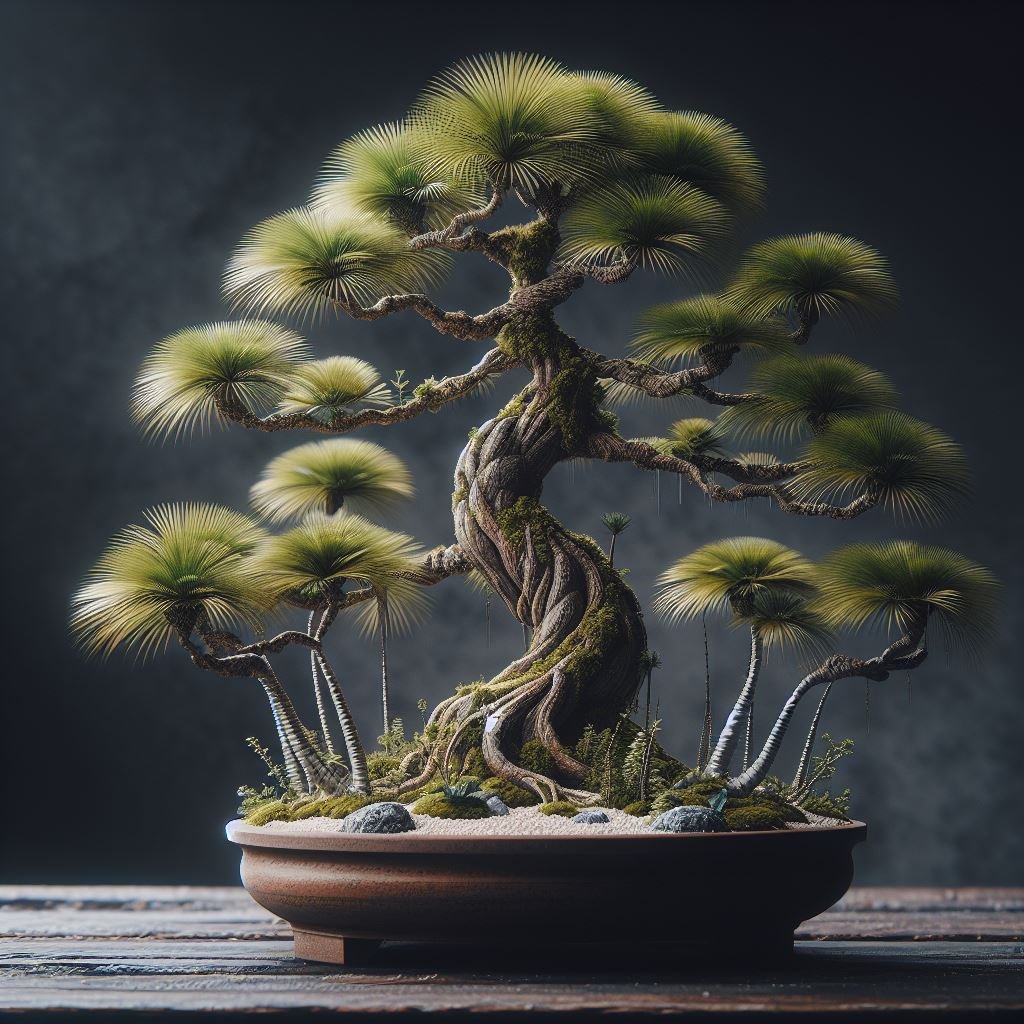Introduction
The art of bonsai is a harmonious blend of horticulture and creativity. It’s a testament to the resilience of nature and human ingenuity. Among these miniature marvels, one variant stands out — the Coconut Bonsai Tree. Its charm lies in its unique blend of tropical allure and traditional bonsai elegance. This blog post aims to delve into the history, care, common issues, and benefits of these captivating trees.
History and Origin of Bonsai Coconut Trees
The art of bonsai originated in China over a thousand years ago, inspired by the natural landscapes. It was later adopted and refined by Japanese culture, which is where most of us recognize it today. Bonsai art involves cultivating miniature trees that mirror the shape and scale of their full-sized counterparts.

Bonsai coconut trees are a relatively recent addition to the bonsai family. Their development was fueled by a fascination with tropical flora and the desire to bring a piece of the tropics into homes and gardens worldwide. The resulting Bonsai Coconut Tree, with its miniature coconuts and palm-like fronds, offers a unique twist on traditional bonsai styles.
Cultivation and Care Tips
Cultivating a Bonsai Coconut Tree is a rewarding endeavor, and with the right guidance, even beginners can enjoy the process. Here are some tips to get you started:
Selection and Preparation: Choose a healthy coconut with its husk intact. Soak it in water until roots start to emerge, then select a suitable pot for planting. The pot should be large enough to accommodate growth but small enough to maintain the bonsai’s miniature size.
Watering and Pruning: Water your Bonsai Coconut Tree regularly, but take care not to overwater. Prune the leaves and roots as needed to maintain its shape and size, mimicking the appearance of a full-sized coconut tree.
Soil, Light and Temperature: Bonsai Coconut Trees prefer well-draining soil mixes and a sunny position. They also require warm temperatures, making them well-suited to indoor environments in cooler climates.
Common Issues and Solutions
Like any plant, Bonsai Coconut Trees may encounter a few issues along the way:

Pests and Diseases: Watch out for common pests like mealybugs and spider mites. Use organic pesticides or insecticidal soap to combat infestations. Fungal diseases can be prevented with proper watering and ventilation.
Nutrient Deficiencies: Yellowing leaves may indicate a lack of essential nutrients. Use a balanced fertilizer to ensure your Bonsai Coconut Tree gets the nutrients it needs.
Overwatering: This can lead to root rot, a common issue for many bonsai trees. If the leaves turn yellow or brown, consider reducing your watering.
Benefits and Uses of Bonsai Coconut Trees
Not only do Bonsai Coconut Trees make an intriguing conversation piece, but they also bring a range of benefits:
Aesthetic Appeal: The tropical charm of these trees adds an exotic touch to interiors. Their striking appearance makes them a focal point in any room or garden.
Symbolism: The coconut tree is often viewed as a symbol of resilience and versatility, attributes that are reflected in the Bonsai Coconut Tree’s ability to adapt to its miniature form.
Decorative Uses: These trees can enhance a range of settings, from home interiors and office spaces to outdoor gardens and patios. They can also serve as unique gifts for plant enthusiasts.
How tall do bonsai coconut trees grow?
Bonsai coconut trees are a miniature version of full-sized coconut trees, which can grow up to 100ft (30m) in their natural habitat. However, when grown as a bonsai, the size is significantly reduced. A young bonsai coconut tree might be about 40cm in height, and even fully grown bonsai coconut trees do not typically exceed a few feet in height.

Remember, the goal of bonsai is to create a miniaturized but realistic representation of nature, so the ultimate size of your bonsai coconut tree will depend on careful pruning and maintenance.
Footnotes
Coconut Bonsai Tree Life Cycle
A coconut bonsai tree’s life cycle starts as a seedling in a small pot, often around 4 inches. When the tree reaches about 4 inches tall, it is considered a sapling and then moved to a larger pot1. The entire process of growing a tree from seeds or cuttings to a pre-bonsai stage ready to be worked upon can take around 2-3 years.
The coconut tree will only grow well in tropical regions and needs a high humidity level for optimal growth, ideally above 75%. You should also report the tree every two to three years to ensure it has enough room for growth and to replenish the soil nutrients.
The life expectancy of a coconut bonsai tree ranges from 60 to 80 years, depending on how well it is cared for. However, some bonsai trees could live up to a hundred or even a thousand years.
What is the best climate for the bonsai coconut tree?
The best climate for a bonsai coconut tree is a tropical, humid environment. They thrive in temperatures above 85°F (30°C) during the summer, and prefer high humidity levels, ideally above 75%.
However, they can tolerate temperatures as low as 64 degrees Fahrenheit, with some sources suggesting that anything between 65°F and 75°F works well. It’s important to note that below 64 degrees Fahrenheit, the plant may fail to thrive.
Additionally, these trees require a significant amount of sunlight, ideally receiving at least six hours of bright, indirect sunlight daily.
Can I grow coconut bonsai in water?
Yes, it is possible to grow a coconut bonsai in water. This method, known as hydroponics, allows the plant to receive nutrients directly from the water instead of through the soil. However, it’s important to note that this method might require more attention and care compared to growing in soil.
In addition, while the coconut bonsai can grow in water for some time, it may not be a long-term solution. Coconut palms are large, tropical trees, and their roots would eventually need more space than what a pot filled with water can provide.
So, while you can start your coconut bonsai in water, you’ll likely need to transition it to soil at some point for it to continue thriving.
Summary of Coconut Bonsai Tree
| Aspect | Information |
|---|---|
| Propagation | Coconut bonsai can only be grown from seeds (coconuts) collected from a healthy, fully grown coconut tree. |
| Creation | A coconut bonsai is a small indoor tree made from a young coconut plant. |
| Care | Coconut bonsai needs enough water, sunny location, and regular fertilization. |
| Sunlight Requirement | Coconut bonsai should get between six and eight hours of bright, direct sunlight per day. |
| Planting Process | Start with a pot, add planting medium as high as 5 cm, put the coconut seeds into it. |
| Soil Requirement | Coconut bonsai prefer well-draining soil. The ideal mixture is one part peat, one part garden soil, and one part coarse sand. |
| Fertilizer Requirement | Regular fertilization is necessary for proper growth. Use a balanced slow-release fertilizer with equal amounts of Nitrogen, Phosphorus, and Potassium. |
| Pruning | Pruning helps to maintain the shape of your bonsai and should be done carefully. Always prune above a leaf node. |
| Repotting | Coconut bonsai should be repotted every two years during spring. This helps to replenish the soil’s nutrients. |
| Pest Control | Keep an eye out for common pests like aphids and spider mites. Use organic pesticides to control them. |
| Watering | Water your coconut bonsai thoroughly until water starts flowing out of the pot’s drainage holes. However, avoid waterlogging as it can lead to root rot. |
| Indoor/Outdoor | Coconut bonsai can be grown both indoors and outdoors. However, they need plenty of sunlight and warm temperatures to thrive. |
| Growth Time | It can take several years for your coconut bonsai tree to reach its full potential. Patience is key in bonsai cultivation. |
| Temperature Requirement | Coconut bonsai prefer warm temperatures and should be kept in an environment above 18°C (64°F). |
| Humidity | High humidity levels can benefit the coconut bonsai. Consider using a humidity tray or misting the plant regularly. |
| Winter Care | In colder climates, it’s best to bring your coconut bonsai indoors during winter to protect it from frost. |
| Common Issues | Overwatering and insufficient light are common issues. Signs of these can include yellowing leaves or stunted growth. |
| Size | The size of a coconut bonsai can vary, but with proper care and training, it can be kept small and manageable. |
| Cost | The cost of a coconut bonsai can vary depending on its age and size. It’s cheaper to grow one from seed, but it requires more time and patience. |
| Lifespan | With proper care, a coconut bonsai can live for many years, providing beauty and interest to your home or garden. |
| Training Techniques | Wiring and pruning are common techniques used to shape and train a coconut bonsai. Always be gentle to avoid damaging the tree. |
| Health Check | Regularly check your coconut bonsai for signs of disease or pests. Early detection is key to preventing major problems. |
Conclusion
The Bonsai Coconut Tree is a fascinating fusion of tropical charisma and bonsai artistry. Its cultivation is a rewarding journey, offering both aesthetic appeal and a deep sense of satisfaction. Despite potential challenges, the care and maintenance of these unique trees are manageable even for novice gardeners.
The allure of Bonsai Coconut Trees lies in their capacity to encapsulate the majesty of a full-sized tree within a miniature form, bringing the tropics’ charm to the comfort of your home or garden. It’s a testament to nature’s adaptability and the endless possibilities of bonsai art. Whether you’re a seasoned bonsai enthusiast or a curious beginner, embracing the art of Bonsai Coconut Trees is a journey worth embarking on.
Frequently Asked Questions
How often should I water my Bonsai Coconut Tree?
Watering frequency may vary depending on the tree’s size, the pot’s size, and the climate. Generally, ensure the soil is slightly damp and never let it dry out completely. Overwatering can lead to root rot, so avoid saturating the soil.
Can I grow the Bonsai Coconut Tree indoors?
Yes, you can grow a Bonsai Coconut Tree indoors. However, remember that they require a significant amount of sunlight, so place them near a window where they can receive at least six hours of bright, indirect sunlight daily.
What kind of soil is best for the Bonsai Coconut Tree?
A well-draining soil mix is ideal for Bonsai Coconut Trees. It ensures the roots are not waterlogged and allows them to breathe.
How often should I repot my Bonsai Coconut Tree?
Repotting every two to three years is generally advisable. The exact timings can depend on the tree’s growth rate and the size of the pot.
Can the Bonsai Coconut Tree survive in cold climates?
Bonsai Coconut Trees prefer tropical, humid environments. While they can tolerate temperatures as low as 64 degrees Fahrenheit, they may fail to thrive if the temperature drops below this.





